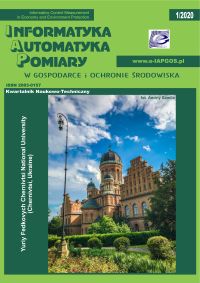SZYFRY BLOKOWE NA PODSTAWIE ODWRACALNYCH AUTOMATÓW KOMÓRKOWYCH
##plugins.themes.bootstrap3.article.sidebar##
Open full text
Numer Tom 10 Nr 1 (2020)
-
ZASTOSOWANIE WSKAŹNIKA HURSTA W SIECI TELEKOMUNIKACYJNEJ DLA WYBORU ALGORYTMU STEROWANIA
Anton Vrublevskiy, Ivan Lesovoy, Gennadij Pylypenko4-7
-
SZYFRY BLOKOWE NA PODSTAWIE ODWRACALNYCH AUTOMATÓW KOMÓRKOWYCH
Yuliya Tanasyuk, Petro Burdeinyi8-11
-
URZĄDZENIE PRZEŁĄCZAJĄCE INTERWAŁ CZASOWY
Ruslan Politanskyi, Andrij Veryga12-15
-
ŚRODOWISKO KOMPATYBILNOŚCI ELEKTROMAGNETYCZNEJ ŚRODKÓW KOMUNIKACJI RADIOELEKTRONICZNEJ
Heorhii Rozorinov, Oleksandr Hres, Volodymyr Rusyn, Petro Shpatar16-19
-
GENEROWANIE SEKWENCJI LOSOWYCH O ZWIĘKSZONEJ SILE KRYPTOGRAFICZNEJ
Volodymyr Korchynskyi, Vitalii Kildishev, Oleksandr Riabukha, Oleksandr Berdnikov20-23
-
ZWIĘKSZENIE WYDAJNOŚCI ENERGETYCZNEJ SPRZĘTU RADIOWEGO W OPARCIU O STOSOWANIE MODULACJI PRZEZ ORTOGONALNE HARMONICZNE
Sergey Toliupa, Vladimir Nakonechnyi, Alexander Trush24-27
-
SYNTEZA ALGORYTMÓW BEZPIECZNEGO POSTĘPOWANIA W SYSTEMACH RADIOELEKTRONICZNYCH DO ZASTOSOWAŃ W SYTUACJACH KRYTYCZNYCH
Leonid Ozirkovskyy, Bohdan Volochiy, Mykhailo Zmysnyi, Oleksandr Shkiliuk28-31
-
METODA OCENY STRUKTURALNEJ NIEZAWODNOŚCI SIECI O NIEOKREŚLONEJ TOPOLOGII
Nina Kniazieva, Alexey Nenov, Irina Kolumba32-35
-
FOTODIODA OPARTA NA EPITAKSJALNYM FOSFORKU GALU O ZWIĘKSZONEJ WRAŻLIWOŚCI PRZY DŁUGOŚCI FALI 254 nm
Yurii Dobrovolsky, Volodymyr M. Lipka, Volodymyr V. Strebezhev, Yurii O. Sorokatyi, Mykola O. Sorokatyi, Olga P. Andreeva36-39
-
OKREŚLENIE POSTACI STRUKTURALNEJ ORAZ STABILNOŚCI POWIERZCHNI KRYSZTAŁU Cd1-xМnxTe KRYSTALIZOWANEJ LASEREM
Victor Strebezhev, Ivan Yuriychuk, Petro Fochuk, Sergiy Nichyi, Yuriy Dobrovolsky, Victoria Tkachuk, Mykola Sorokatyi, Yurii Sorokatyi40-43
-
TECHNOLOGIA I POMIARY MAGNETOOPORU W CIENKOWARSTWOWYCH STRUKTURACH FERROMAGNETYCZNYCH
Jakub Kisała, Karolina Czarnacka, Mateusz Gęca, Andrzej Kociubiński44-47
-
BADANIE WŁAŚCIWOŚCI PERMUTACJI PIKSELI W OPARCIU O ZDYSKRETYZOWANĄ MAPĘ STANDARDOWĄ
Serhii Haliuk, Oleh Krulikovskyi, Vitalii Vlasenko48-51
-
TECHNIKI ROZPOZNAWANIA TWARZY
Olexandr N. Romanyuk, Sergey I. Vyatkin, Sergii V. Pavlov, Pavlo I. Mykhaylov, Roman Y. Chekhmestruk, Ivan V. Perun52-57
-
BADANIE FILTRU KOŁMOGOROWA-WIENERA DLA CIĄGŁYCH PROCESÓW FRAKTALNYCH W OPARCIU O WIELOMIANY CZEBYSZEWA PIERWSZEGO RODZAJU
Vyacheslav Gorev, Alexander Gusev, Valerii Korniienko58-61
-
MODELOWANIE URZĄDZEŃ SPINTRONICZNYCH DO ZASTOSOWANIA W PAMIĘCI O DOSTĘPIE SWOBODNYM RAM
Ruslan Politanskyi, Maria Vistak, Andriy Veryga, Tetyana Ruda62-65
-
SPRZĘT I OPROGRAMOWANIE DO BADAŃ ELEMENTÓW ELEKTRONICZNYCH I CZUJNIKÓW
Gryhoriy Barylo, Oksana Boyko, Ihor Gelzynskyy, Roman Holyaka, Zenon Hotra, Tetyana Marusenkova, Mykola Khilchuk, Magdalena Michalska66-71
-
ODNAWIALNA ENERGIA ELEKTRYCZNA Z DWUTLENKU WĘGLA
Natalia Grigorieva, Viktor Shabaykovich, Larysa Gumeniuk, Pavlo Humeniuk, Lubov Dobrovolska, Dmitry Sobchuk72-76
-
NASYCENIE PROCESU ABSORPCJI PROMIENIOWANIA TERMICZNEGO W ATMOSFERYCZNYM DWUTLENKU WĘGLA
Jan Kubicki, Krzysztof Kopczyński, Jarosław Młyńczak77-81
-
KLASYFIKACJA WYNIKÓW WIELOWYMIAROWEJ MIKROSKOPII POLARYZACYJNEJ W TECHNOLOGII INTELIGENTNEGO MONITOROWANIA CHORÓB SERCA W MEDYCYNIE SĄDOWEJ
Oleg Vanchulyak, Serhii Golub, Mariia Talakh, Vyacheslav Gantyuk82-86
Archiwum
-
Tom 12 Nr 4
2022-12-30 16
-
Tom 12 Nr 3
2022-09-30 15
-
Tom 12 Nr 2
2022-06-30 16
-
Tom 12 Nr 1
2022-03-31 9
-
Tom 11 Nr 4
2021-12-20 15
-
Tom 11 Nr 3
2021-09-30 10
-
Tom 11 Nr 2
2021-06-30 11
-
Tom 11 Nr 1
2021-03-31 14
-
Tom 10 Nr 4
2020-12-20 16
-
Tom 10 Nr 3
2020-09-30 22
-
Tom 10 Nr 2
2020-06-30 16
-
Tom 10 Nr 1
2020-03-30 19
-
Tom 9 Nr 4
2019-12-16 20
-
Tom 9 Nr 3
2019-09-26 20
-
Tom 9 Nr 2
2019-06-21 16
-
Tom 9 Nr 1
2019-03-03 13
-
Tom 8 Nr 4
2018-12-16 16
-
Tom 8 Nr 3
2018-09-25 16
-
Tom 8 Nr 2
2018-05-30 18
-
Tom 8 Nr 1
2018-02-28 18
##plugins.themes.bootstrap3.article.main##
DOI
Authors
Abstrakt
The given paper is devoted to the software development of block cipher based on reversible one-dimensional cellular automata and the study of its statistical properties. The software implementation of the proposed encryption algorithm is performed in C# programming language in Visual Studio 2017. The paper presents specially designed approach for key generation. To ensure desired cryptographic stability, the shared secret parameters can be adjusted to contain information needed for creating substitution tables, defining reversible rules, and hiding final data. For the first time, it is suggested to create substitution tables based on iterations of a cellular automaton that is initialized by the key data.
Słowa kluczowe:
Bibliografia
Bouchkaren S., Lazaar S.: A fast cryptosystem using reversible cellular automata. International Journal of Advanced Computer Science and Applications 5(5)/2014, 207–210. DOI: https://doi.org/10.14569/IJACSA.2014.050531
Debasis D., Abhishek R.: A parallel encryption algorithm for block ciphers based on programmable reversible cellular automata. J. Computer Science and Engineering 1(1)/2010, 82–90.
Gutowitz H.A.: Cryptography with Dynamical Systems: Cellular Automata and Cooperative Phenomena. Kluwer Academic Press, Dordrecht 1993. DOI: https://doi.org/10.1007/978-94-011-1691-6_21
Paar C., Peltz J.: Understanding cryptography. Springer-Verlag, Berlin Heidelberg 2010. DOI: https://doi.org/10.1007/978-3-642-04101-3
Leporati A., Mariot L.: Cryptographic properties of bipermutive cellular automata rules. J. Cellular Automata 9/2014, 437–475.
Seredynski M., Bouvry P.: Block cipher based on cellular automata. New Generation computing 23(3)/2005, 245–258. DOI: https://doi.org/10.1007/BF03037658
Seredynski F., Bouvry P., Zomaya A. Y.: Cellular automata and secret key cryptography. Parallel Computing 30(5-6)/2004, 753–766, [DOI:10.1016/j.parco.2003.12.014]. DOI: https://doi.org/10.1016/j.parco.2003.12.014
Tomassini M., Perrenoud M.: Stream Cyphers with One- and Two-Dimensional Cellular Automata. Parallel Problem Solving from Nature PPSN VI. PPSN. Lecture Notes in Computer Science vol. 1917. Springer, Berlin, Heidelberg, 2000, 722–731.
Wolfram S.: Cryptography with Cellular Automata.: Advances in Cryptology: Crypto’85, Springer-Verlag LNCS 218, 1985, 429–432. DOI: https://doi.org/10.1007/3-540-39799-X_32
NIST SP 800-22: Documentation and Software. Random bit generation. - Guide to the statistical tests, https://csrc.nist.gov/Projects/Random-Bit-Generation/Documentation-and-Software/Guide-to-the-Statistical-Tests
Wolfram S.: A New Kind of Science.: Wolfram Media, Inc, 2002, 1197, http://www.wolframscience.com/nksonline/toc.html
##plugins.themes.bootstrap3.article.details##
Abstract views: 468
Licencja

Utwór dostępny jest na licencji Creative Commons Uznanie autorstwa – Na tych samych warunkach 4.0 Miedzynarodowe.






